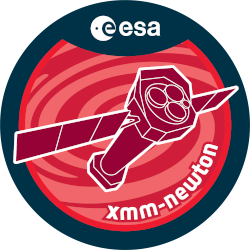

| Proposal ID | 008324 |
| Title | Groups and clusters near multiply lensed QSOs |
| Download Data Associated to the proposal | https://nxsa.esac.esa.int/nxsa-sl/servlet/data-action-aio?obsno=0083240201 |
| DOI | https://doi.org/10.5270/esa-9std489 |
| Principal Investigator, PI | Dr Jens Hjorth |
| Abstract | Gravitationally lensed QSOs are powerful tools for measuring cosmologicalparameters if their lens potentials can be adequately constrained. Groups andclusters of galaxies close to the line of sight to multiply lensed QSOscontribute significantly to the potential. Such collapsed mass concentrationscan be traced by X-rays. We here propose to map the mass distribution aroundfour well-constrained quadruple lenses with 0.3 < z < 0.8 and predictedtemperatures 1 keV < kT < 6 keV. The primary aim of these observations will beto constrain the mass models of the lenses, to study the low-mass end of scalingrelations relating mass to X-ray observables and finaly to put constrains on theHubble constant and the cosmological constant. |
| Publications |
|
| Instrument | EMOS1, EMOS2, EPN, OM, RGS1, RGS2 |
| Temporal Coverage | 2001-11-02T02:01:20Z/2001-11-02T07:45:46Z |
| Version | 17.56_20190403_1200 |
| Mission Description | The European Space Agencys (ESA) X-ray Multi-Mirror Mission (XMM-Newton) was launched by an Ariane 504 on December 10th 1999. XMM-Newton is ESAs second cornerstone of the Horizon 2000 Science Programme. It carries 3 high throughput X-ray telescopes with an unprecedented effective area, and an optical monitor, the first flown on a X-ray observatory. The large collecting area and ability to make long uninterrupted exposures provide highly sensitive observations. Since Earths atmosphere blocks out all X-rays, only a telescope in space can detect and study celestial X-ray sources. The XMM-Newton mission is helping scientists to solve a number of cosmic mysteries, ranging from the enigmatic black holes to the origins of the Universe itself. Observing time on XMM-Newton is being made available to the scientific community, applying for observational periods on a competitive basis. |
| Creator Contact | https://www.cosmos.esa.int/web/xmm-newton/xmm-newton-helpdesk |
| Date Published | 2002-11-23T00:00:00Z |
| Last Update | 2025-08-04 |
| Keywords | "mass distribution", "constrained quadruple lenses", "gravitationally lensed qsos", "powerful tools", "lens potentials", "cosmological constant", "mass models", "collapsed mass concentrations", "adequately constrained", "galaxy close", "multiply lensed qsos", "predicted temperatures", "cosmological parameters", "low mass", "hubble constant", "xray observables" |
| Publisher And Registrant | European Space Agency |
| Credit Guidelines | European Space Agency, Dr Jens Hjorth, 2002, 'Groups and clusters near multiply lensed QSOs', 17.56_20190403_1200, European Space Agency, https://doi.org/10.5270/esa-9std489 |